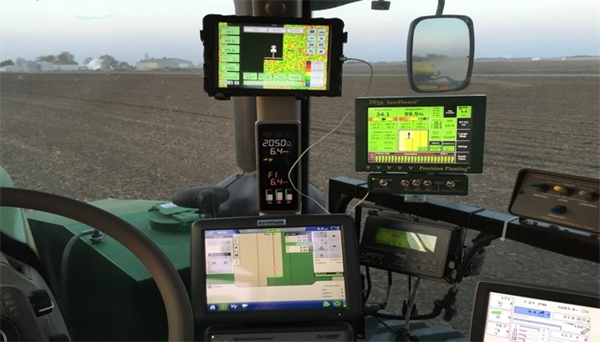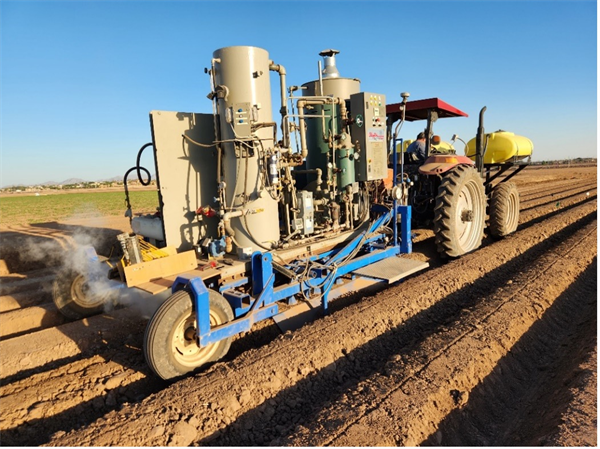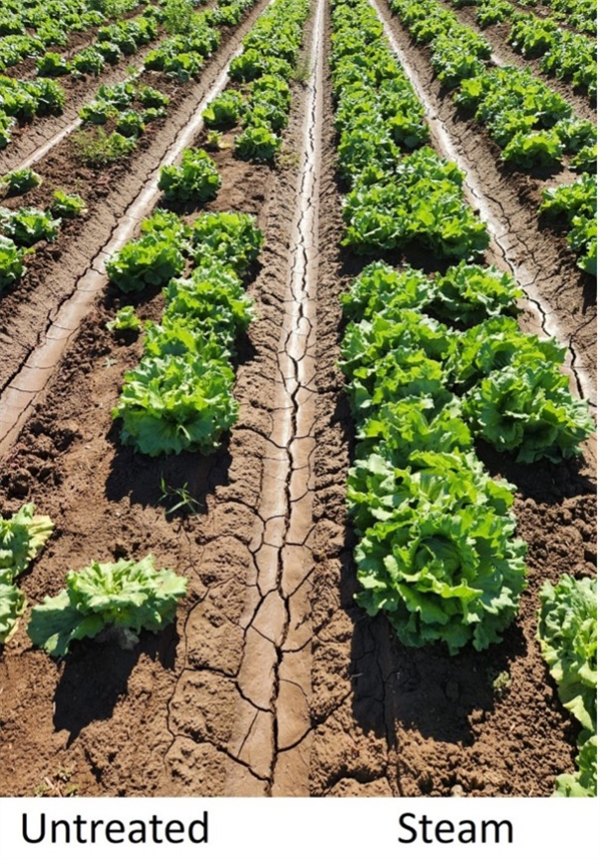
The continuous development, testing, and incorporation of technology in agriculture is amazing. I recently attended a western agricultural conference and when visiting the industry displays and booths, I was impressed with the new technologies that are coming into the agricultural arena.
Technological devices are tools and like all other tools, they are put to their best use in the hands of skilled craftsmen.
We have many excellent examples of technological tools in the crop production systems of the desert Southwest. A basic example comes from the equipment used to till the fields, prepare a good seedbed, and then to plant a new crop by seed or transplant. Excellent articles are provided in this newsletter on this topic regularly. We tend to take this kind of equipment for granted until you must do the job by hand or with older technology.
Any new technology needs to be fully tested and demonstrated before anyone can expect it to be appropriately implemented. That involves communicating the background, purpose, and utility of any new technology. The cost/benefit ratios need to be worked out and presented. A critical step in implementation is demonstration and establishing prima facie evidence to support the value of the new technology. Testimonials are nice but there needs to be solid evidence to support claims of merit. In science ideas demand testing and the presentation of proof.
A lot of emphasis recently has been placed on the technology and new tools available for soil-plant-water management and irrigation management. There is a tendency for some people to think that our problems can all be solved with crop water management if we would just use the right technology. In my view, some of the new irrigation technology is great and it can potentially be very useful in managing crop irrigation in the field. But technology itself is not a panacea.
Despite the technological advancements that we do use and benefit from, the best potential improvements are dependent upon the skill and expertise of the farmers or field managers involved. The skill set required to plant a crop, get a good stand, manage it to the proper level of maturity, harvest the crop, and then get it to market is indispensable and the responsibility comes down to individual farmers and farmer managers.
The successful management of irrigation technology is totally dependent on the skill of the operator to make a personal assessment of a broad array of factors. These factors include a review and assessment of the field in terms of crop condition and stage of growth, the soil moisture levels in relation to field capacity of the soil, the crop-specific irrigation requirements, allocating the appropriate amount of irrigation water needed, and the optimum time of application.
The ability of the farmer and/or farm manager to evaluate soils in the field regarding texture, water holding capacity, and current soil-water levels is essential. Simple methods such as using a soil probe and estimating soil-water levels by feel with their hands remains and will continue to be a critical skill for farmers and field managers.
I believe this is particularly true if one is trying to employ new technologies for irrigation management. A good farmer can tell if the tools and technologies being employed are working properly. They are the ones that usually take new tools to levels of use above and beyond what the developers were able to envision.
We all need a baseline in relation to crop-water management and the fundamentals will continue to be an important part of a farm manager’s skill set. The new technologies may serve as good tools, but they will not replace the capacity of a farm manager to go into the field and figure out what is going on, put the tools or technologies to work appropriately, and not only apply them but do it well.
Fundamentals are important, and they always will be. This illustrates the fact that skilled professionals are essential in crop production.

Frost and freeze damage affect countless fruit and vegetable growers leading to yield losses and occasionally the loss of the entire crop. Frost damage occurs when the temperature briefly dips below freezing (32°F).With a frost, the water within plant tissue may or may not actually freeze, depending on other conditions. A frost becomes a freeze event when ice forms within and between the cell walls of plant tissue. When this occurs, water expands and can burst cell walls. Symptoms of frost damage on vegetables include brown or blackening of plant tissues, dropping of leaves and flowers, translucent limp leaves, and cracking of the fruit. Symptoms are usually vegetable specific and vary depending on the hardiness of the crop and lowest temperature reached. A lot of times frost injury is followed by secondary infection by bacteria or opportunist fungi confusing with plant disease.
Most susceptible to frost and freezing injury: Asparagus, snap beans, Cucumbers, eggplant, lemons, lettuce, limes, okra, peppers, sweet potato
Moderately susceptible to frost and freezing injury: Broccoli, Carrots, Cauliflower, Celery, Grapefruit, Grapes, Oranges, Parsley, Radish, Spinach, Squash
Least susceptible to frost and freezing injury: Brussels sprouts, Cabbage, Dates, Kale, Kohlrabi, Parsnips, Turnips, Beets
More information:
In a prior article (Vol. 14, Issue 19), I discussed the initiation of a fall 2023 trial examining the use of band steam for controlling Fusarium wilt of lettuce. Again, the premise behind the research is to use steam heat to raise soil temperatures to levels sufficient to kill soilborne pathogens. For Fusarium oxysporum f. sp. lactucae (FOL) the pathogen which causes Fusarium wilt of lettuce, the required temperature for control is generally taken to be > 140°F for 20 minutes. Soil solarization, where clear plastic is placed over the crop bed during the summer, exploits this concept. The technique raises soil surface temperatures to 150-155˚F, effectively killing the pathogen and reducing FOL disease incidence by 45-98% (Matheron and Porchas, 2010).
In our trials, we used steam heat to raise soil temperatures. Steam was delivered by a 35 BHP steam generator mounted on a custom designed elongated bed shaper (Fig. 1). As the device traveled through the field, steam was injected into the soil in narrow bands centered on the seedline. Four band sizes ranging from 4” wide x 2” deep to 6” wide by 4” deep were examined to determine the optimal width and depth of the band of soil that needs to be disinfested to prevent disease. Travel speed was 0.2 mph and soil temperatures were raised to about 190°F. After cooling (< ½ a day), the crop (FOL susceptible iceberg lettuce variety El Guapo) was planted into the disinfested soil.
Preliminary results are very encouraging (Table 1, Fig. 2). The percentage of diseased plants was roughly four times lower in steam treated plots as compared to the untreated plots at the first evaluation date, 39 days after planting (DAP) (19% vs ~ 5%), and about two times lower at the second evaluation date, 60 DAP (32% vs ~17%). These results are consistent with our previous studies which showed that in soils that have moderate FOL inoculum levels, steam treatment reduced disease incidence at maturity by more than 40%. A surprising result was that the width and depth of soil steam treatment did not have a significant effect on disease incidence. A logical explanation for this result could not be formulated as one would expect disease incidence to be reduced if a larger volume of soil is disinfested.
Stay tuned for final trial results!
On a slightly different note, if you are interested in seeing the plots, I will be at the field site Field Day this Wednesday, November 30th from 8:00 am-12:00 pm. The location is the JV Farms Fusarium Trial site, located off of Hwy 95 and Ave 5E (32.6920898, -114.5395051).
Hope to see you there!
References
Matheron, M. E., & Porchas, M. 2010. Evaluation of soil solarization and flooding as management tools for Fusarium wilt of lettuce. Plant Dis. 94:1323-1328.
Acknowledgements
This project is sponsored by USDA-NIFA, the Arizona Specialty Crop Block Grant Program and the Arizona Iceberg Lettuce Research Council. We greatly appreciate their support.
A special thank you is extended to Fatima Corona, Pablo Delgado, Chad VanMatre, Matt McGuire and JV Farms for their generous assistance and allowing us to conduct this research on their farm.
|
Table 1. Effect of band-steam on Fusarium wilt of lettuce disease incidence in a trial conducted with iceberg lettuce in Yuma, AZ in 2023. |
||
|
|
----------------- Disease Incidence, % ----------------- |
|
|
Treatment1 |
39 DAP2 |
60 DAP |
|
Band-steam: 4”x2” |
2.4 |
17.5 |
|
Band-steam: 4”x4” |
5.0 |
15.0 |
|
Band-steam: 6”x2” |
8.5 |
22.4 |
|
Band-steam: 6”x4” |
3.8 |
16.4 |
|
Untreated |
19.2 |
32.1 |
|
1Dimensions for band-steam treatments indicate the width and depth of the band of soil that was treated with steam. |
||

Fig. 1. Band-steam applicator principally comprising a 35 BHP steam generator
mounted on a bed-shaper applicator sled. The device injects steam into the soil
as beds are formed.

Fig. 2. Fusarium wilt of lettuce control with band-steam in iceberg
lettuce. Steam was applied in a narrow band (4” wide x 4” deep)
centered on the seedline prior to planting. After the soil cooled (< 1/2
day), the crop was planted into the disinfested soil.
Burndown herbicides are used to kill emerged weeds prior to planting lettuce. Some of the species we have are very hard to kill. Therefore, these weeds would have to be controlled using selective herbicides after the crop has emerged.
Some of the products we have available are glyphosate (Roundup), paraquat (Gramoxone), oxyfluorfen (GoalTender), carfentrazone (Aim,Shark), Pyraflufen (ET), and pelargonic acid (Scythe). There are other products that are being developed such as the S3100 from Valent USA.
Herbicides that can be used up to just before crop emergence are Roundup, Paraquat and Scythe, these provide no residual weed control. ET has an interval of 1 day following preplant burndown application for leafy vegetables. AIM herbicide also requires for some crops (tobacco) 1 day following preplant burndown1. Oxyfluorfen does not bind strongly to soil but stays active for a long time and requires ninety days after application for the low rate and 120 days for the high rate prior to planting lettuce4. It forms a layer on the soil surface that weeds contact as they emerge. If this barrier is destroyed by machinery traffic weeds will not be controlled.
Roundup is a systemic and with a Koc (sorption coefficient) factor of 24,000 adheres very strongly to the soil. So, it is active only on growing plants, but once its bind to the soil is inactive.
Paraquat also adheres good to the soil with a Koc of 1,000,000, so coverage is important for best weed control.
There is a project through the IR-4 program to add the use of glufosinate as a Pre-Plant burndown on spinach, lettuce, broccoli, cabbage, and mustard greens. Hopefully this addition to the label will provide a new tool for our growers in Arizona and other States3
Results of pheromone and sticky trap catches can be viewed here.
Corn earworm: CEW moth counts remain at low levels in all areas, well below average for this time of year.
Beet armyworm: Trap increased areawide; above average compared to previous years.
Cabbage looper: Cabbage looper counts decreased in all areas; below average for this time of season.
Diamondback moth: DBM moth counts decreased in most areas. About average for this time of the year.
Whitefly: Adult movement beginning at low levels, average for early spring.
Thrips: Thrips adult counts reached their peak for the season. Above average compared with previous years.
Aphids: Aphid movement decreased in all areas; below average for late-March.
Leafminers: Adults remain low in most locations, below average for March.